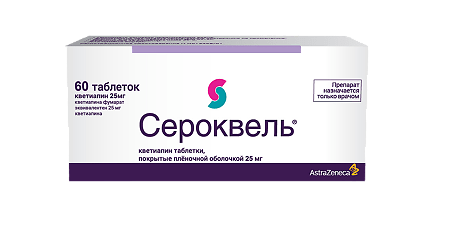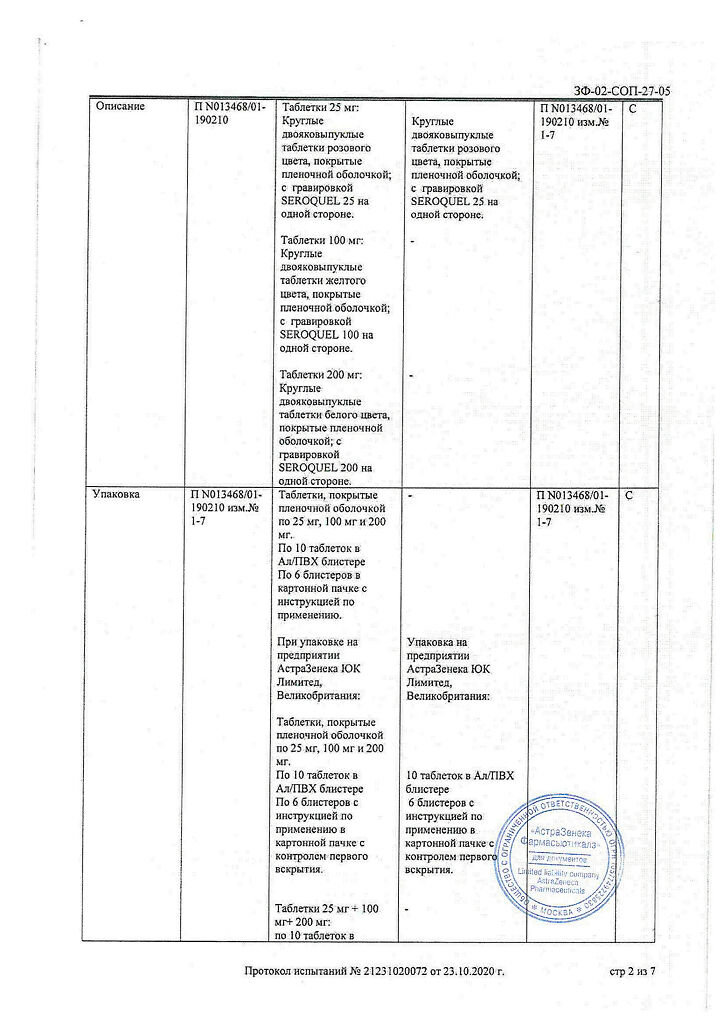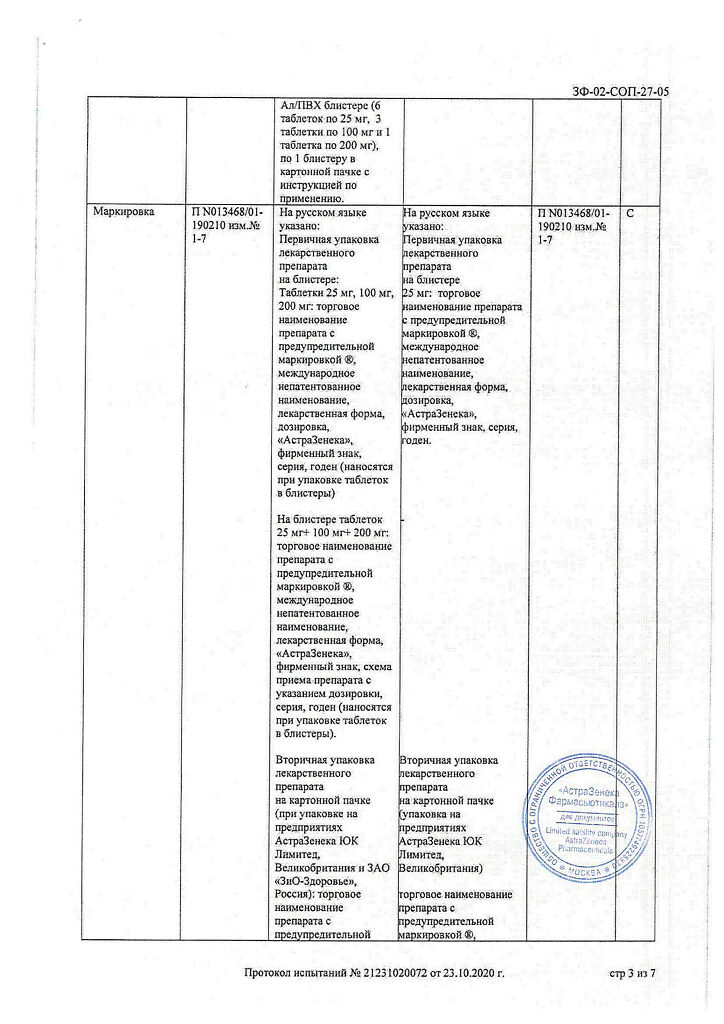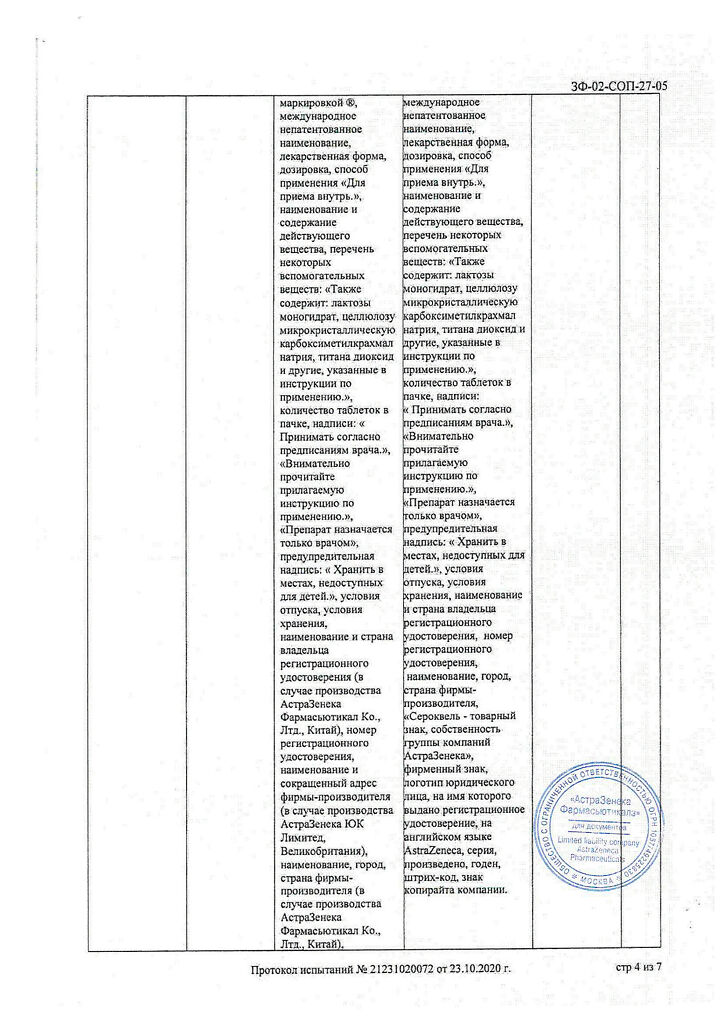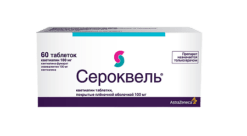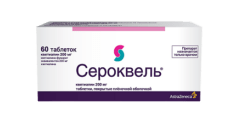No products in the cart.
Seroquel, 25 mg 60 pcs
€26.81 €23.23
Out of stock
(E-mail when Stock is available)
Description
Quetiapine is an atypical antipsychotic. Quetiapine and its active metabolite N-dezalkylquetiapine (norquetiapine) interact with a wide range of brain neutrotransmitter receptors. Quetiapine and N-dezalkylquetiapine exhibit high affinity for 5HT2-serotonin receptors and brain D1- and D2-dopamine receptors. This receptor antagonism combined with a higher selectivity for 5HT2-serotonin receptors than for D2-dopamine receptors provides the clinical antipsychotic properties of Seroquel® and the low frequency of extrapyramidal side effects.
Quetiapine has no affinity for the noradrenaline transporter and low affinity for the 5HT1A-serotonin receptor, whereas N-dezalkylquetiapine has high affinity for both. Inhibition of the noradrenaline transporter and partial agonism at the 5HT1A-serotonin receptor by N-desalkylquetiapine may account for the antidepressant effects of Seroquel®. Quetiapine and N-desalkylquetiapine have a high affinity for histamine and α1-adrenoreceptors and a moderate affinity for α2-adrenoreceptors. In addition, quetiapine has no or low affinity for muscarinic receptors, whereas N-dezalkylquetiapine has moderate to high affinity for several muscarinic receptor subtypes.
In standard tests, quetiapine exhibits antipsychotic activity.
The specific contribution of the metabolite N-dezalkyl vetiapine to the pharmacological activity of vetiapine has not been established.
The results of a study of extrapyramidal symptoms (EPS) in animals revealed that quetiapine causes mild catalepsy at doses that effectively block D2 receptors. Quetiapine causes a selective decrease in the activity of mesolimbic A10-dopaminergic neurons compared to A9-nigrostriate neurons involved in motor function.
The drug Seroquel® is effective against both positive and negative symptoms of schizophrenia.
Seroquel® is effective as monotherapy for manic episodes of moderate to severe severity. There are no data on long-term use of Seroquel® for prevention of subsequent manic and depressive episodes.
The data on the use of Seroquel® in combination with valproate seminatria or lithium preparations for moderate to severe manic episodes are limited, but this combination therapy was generally well tolerated. In addition, Seroquel® at doses of 300 mg and 600 mg is effective in patients with moderate to severe bipolar disorder types I and II. The efficacy of Seroquel® is comparable when administered in doses of 300 mg and 600 mg per day.
Seroquel® is effective in patients with schizophrenia and mania when taken twice daily, despite the fact that the half-life of quetiapine is about 7 hours.
The effects of quetiapine on 5NT2- and D2-receptors last up to 12 hours after taking the drug.
The incidence of EPS and concomitant use of m-cholinoblockers was comparable to that of placebo when Seroquel® was administered with dose titration in schizophrenia. When Seroquel® was administered in fixed doses of 75 to 750 mg/day to patients with schizophrenia, the incidence of EPS and the need for concomitant use of m-cholinoblockers did not increase.
When Seroquel® was used in doses up to 800 mg/day for the treatment of moderate to severe manic episodes, both as monotherapy and in combination with lithium or valproate seminathrate, the incidence of EPS and concomitant use of m-cholinoblockers was comparable to that with placebo.
Indications
Indications
For the treatment of schizophrenia.
For the treatment of manic episodes in bipolar disorder.
For the treatment of depressive episodes of moderate to severe severity in the structure of bipolar disorder.
Pharmacological effect
Pharmacological effect
Quetiapine is an atypical antipsychotic drug. Quetiapine and its active metabolite N-desalkylquetiapine (norquetiapine) interact with a wide range of neurotransmitter receptors in the brain. Quetiapine and N-desalkylquetiapine exhibit high affinity for 5HT2-serotonin receptors and D1- and D2-dopamine receptors in the brain. Antagonism to these receptors, combined with higher selectivity for 5HT2-serotonin receptors than for D2-dopamine receptors, determines the clinical antipsychotic properties of the drug Seroquel® and the low incidence of extrapyramidal side effects.
Quetiapine has no affinity for the norepinephrine transporter and has low affinity for the 5HT1A-serotonin receptor, while N-desalkylquetiapine exhibits high affinity for both. Inhibition of the norepinephrine transporter and partial agonism of 5HT1A-serotonin receptors, exhibited by N-dealkylquetiapine, may determine the antidepressant effect of Seroquel®. Quetiapine and N-desalkylquetiapine have high affinity for histamine and α1-adrenergic receptors and moderate affinity for α2-adrenergic receptors. In addition, quetiapine has no or low affinity for muscarinic receptors, while N-desalkylquetiapine exhibits moderate to high affinity for several muscarinic receptor subtypes.
In standard tests, quetiapine exhibits antipsychotic activity.
The specific contribution of the N-desalkylquetiapine metabolite to the pharmacological activity of quetiapine has not been established.
The results of a study of extrapyramidal symptoms (EPS) in animals revealed that quetiapine causes mild catalepsy in doses that effectively block D2 receptors. Quetiapine causes a selective decrease in the activity of mesolimbic A10-dopaminergic neurons compared to A9-nigrostriatal neurons involved in motor function.
Seroquel® is effective against both positive and negative symptoms of schizophrenia.
Seroquel® is effective as monotherapy for moderate to severe manic episodes. There are no data on long-term use of Seroquel® for the prevention of subsequent manic and depressive episodes.
Data on the use of Seroquel in combination with semisodium valproate or lithium for moderate to severe manic episodes are limited, but this combination therapy was generally well tolerated. In addition, Seroquel® at doses of 300 mg and 600 mg is effective in patients with moderate to severe bipolar disorder I and II. At the same time, the effectiveness of the drug Seroquel® when taken at a dose of 300 mg and 600 mg per day is comparable.
Seroquel® is effective in patients with schizophrenia and mania when taken twice daily, despite the fact that the half-life of quetiapine is about 7 hours.
The effect of quetiapine on 5HT2 and D2 receptors lasts up to 12 hours after taking the drug.
When taking the drug Seroquel® with dose titration for schizophrenia, the frequency of EPS and concomitant use of m-anticholinergic drugs was comparable to that when taking placebo. When prescribing Seroquel® in fixed doses from 75 to 750 mg/day. In patients with schizophrenia, the incidence of EPS and the need for concomitant use of m-anticholinergic drugs did not increase.
When using the drug Seroquel® in doses up to 800 mg/day. For the treatment of moderate to severe manic episodes, either alone or in combination with lithium or sodium valproate, the incidence of EPS and concomitant use of anticholinergic drugs was comparable to that of placebo.
Special instructions
Special instructions
Caution should be exercised when prescribing Seroquel to patients with cardiovascular and cerebrovascular diseases or other conditions predisposing to arterial hypotension, as well as elderly patients, with liver failure, or a history of seizures.
Seroquel may cause orthostatic hypotension, especially during the initial dose titration period (more common in older patients than in younger patients).
With abrupt withdrawal of high doses of antipsychotic drugs, the following acute reactions (withdrawal syndrome) may be observed: nausea, vomiting; rarely – insomnia.
Cases of exacerbation of psychotic symptoms and the appearance of involuntary movement disorders (akathisia, dystonia, dyskinesia) have been reported. Therefore, it is recommended to discontinue the drug gradually.
The occurrence of NMS may be associated with antipsychotic treatment. Clinical manifestation of the syndrome includes: hyperthermia, altered mental status, muscle rigidity, instability of the autonomic nervous system, increased CPK levels. In such cases, Seroquel should be discontinued and appropriate treatment administered.
There were no differences in the incidence of seizures in patients taking quetiapine or placebo. However, caution is recommended when treating patients with a history of seizures.
There was no relationship between quetiapine and an increase in the QTc interval. However, when prescribing quetiapine concomitantly with drugs that prolong the QTc interval, caution must be exercised, especially in the elderly.
Given that quetiapine primarily affects the central nervous system, quetiapine should be used with caution in combination with other drugs that have a central depressant effect or alcohol.
Impact on the ability to drive vehicles and operate machinery
Seroquel may cause drowsiness, so patients are not recommended to work with dangerous mechanisms, incl. Driving a car or other moving vehicles is not recommended.
Active ingredient
Active ingredient
Quetiapine
Composition
Composition
1 film-coated tablet contains:
active substance:
quetiapine (as fumarate) 25 mg,
excipients:
povidone;
dibasic calcium phosphate dihydrate;
MCC;
starch (sodium glycolate);
lactose monohydrate;
magnesium stearate
shell composition:
iron oxide red; titanium dioxide; hydroxypropyl methylcellulose; polyethylene glycol 400.
Pregnancy
Pregnancy
The safety and effectiveness of quetiapine in pregnant women have not been established. Therefore, during pregnancy, quetiapine can only be used if the expected benefit to the woman justifies the potential risk to the fetus.
When using antipsychotic drugs, including quetiapine, in the third trimester of pregnancy, newborns are at risk of developing adverse reactions of varying severity and duration, including EPS and/or withdrawal syndrome.
Agitation, hypertension, hypotension, tremor, somnolence, respiratory distress, or feeding disturbances have been reported. In this regard, the condition of newborns should be carefully monitored.
Reports of the excretion of quetiapine into breast milk have been published, but the extent of excretion has not been established. Women should be advised to avoid breastfeeding while taking quetiapine.
Contraindications
Contraindications
Hypersensitivity to any of the components of the drug, including lactase deficiency, glucose-galactose malabsorption and galactose intolerance.
Concomitant use with cytochrome P450 inhibitors, such as azole antifungals, erythromycin, clarithromycin and nefazodone, as well as HIV protease inhibitors (see section “Interaction with other drugs and other types of interactions”).
Although the effectiveness and safety of Seroquel® in children and adolescents aged 10-17 years have been studied in clinical studies, the use of Seroquel® in patients under the age of 18 years is not indicated.
With caution: in patients with cardiovascular and cerebrovascular diseases or other conditions predisposing to arterial hypotension, advanced age, liver failure, history of seizures, risk of stroke and aspiration pneumonia.
Side Effects
Side Effects
From the central nervous system and peripheral nervous system: often – drowsiness (17.5%), dizziness (10%); rarely – malignant neuroleptic syndrome (hyperthermia, impaired consciousness, muscle rigidity, vegetative-vascular disorders, increased concentration of CPK); very rarely – convulsions. With long-term use of Seroquel, there is a potential for the development of tardive dyskinesia. If symptoms of tardive dyskinesia occur, the dose should be reduced or further treatment with Seroquel should be discontinued.
From the digestive system: often – constipation (9%), dyspepsia (6%), dry mouth (7%); an increase in the activity of liver enzymes (ALT, AST, GGT) in the blood serum (6%), as well as an increase in the concentration of cholesterol and triglycerides (with treatment with Seroquel, these changes were usually reversible).
From the cardiovascular system: often – orthostatic hypotension (accompanied by dizziness), tachycardia (7%), fainting; These adverse reactions mainly occur during the initial period of dose selection.
From the hematopoietic system: rarely – leukopenia and/or neutropenia. There were no cases of severe neutropenia or agranulocytosis in patients taking Seroquel. When Seroquel was used in clinical practice, leukopenia and/or neutropenia resolved after discontinuation of the drug. Possible risk factors for the development of leukopenia and/or neutropenia include a decrease in the number of leukocytes before starting therapy or a history of drug-induced leukopenia and/or neutropenia.
From the endocrine system: therapy with Seroquel is associated with a small dose-dependent decrease in the level of thyroid hormones, in particular, total T4 and free T4. The maximum decrease in total and free T4 was recorded in the 2nd and 4th weeks of quetiapine therapy, without a further decrease in hormone concentrations during long-term treatment. There were no further signs of clinically significant changes in thyroid-stimulating hormone concentrations. In almost all cases, the concentration of total and free T4 returned to baseline after cessation of quetiapine therapy, regardless of the duration of treatment.
Allergic reactions: rarely – eosinophilia, allergic reactions, including angioedema.
Other: rarely – peripheral edema, moderate asthenia, rhinitis, weight gain (mainly in the first weeks of treatment); very rarely – priapism.
Seroquel may cause a prolongation of the QTc interval; no relationship has been identified between the use of Seroquel and a persistent increase in QTc.
The following frequently occurring (1/100) side effects were also reported: increased blood pressure, palpitations, dysarthria, pharyngitis, cough, anorexia, increased sweating. The cause-and-effect relationship of these side effects with the use of Seroquel has not been established.
Interaction
Interaction
With the simultaneous administration of drugs that have a strong inhibitory effect on the CYP3A4 isoenzyme (such as azole antifungals and macrolide antibiotics), the concentration of quetiapine in plasma may increase. In such cases, lower doses of quetiapine should be used. Particular attention should be paid to elderly and debilitated patients. It is necessary to assess the risk-benefit ratio individually for each patient.
Co-administration of Seroquel with drugs that induce the liver enzyme system, such as carbamazepine, may reduce the plasma concentration of the drug, which may require an increase in the dose of Seroquel, depending on the clinical effect. In a study of the pharmacokinetics of quetiapine, when used in different doses, when prescribed before or simultaneously with carbamazepine (an inducer of liver enzymes), a significant increase in the clearance of quetiapine is possible. This increase in quetiapine clearance decreased AUC by an average of 13% compared with quetiapine without carbamazepine.
The simultaneous administration of Seroquel with another inducer of microsomal liver enzymes (phenytoin) also led to an increase in the clearance of quetiapine. When quetiapine is co-administered with phenytoin (or other hepatic enzyme inducers such as barbiturates, rifampicin), an increase in the dose of quetiapine may be required. It may also be necessary to reduce the dose of Seroquel when discontinuing phenytoin or carbamazepine or another liver enzyme inducer or replacing it with a drug that does not induce liver microsomal enzymes (for example, sodium valproate).
The pharmacokinetics of lithium preparations does not change with the simultaneous administration of Seroquel.
There were no clinically significant changes in the pharmacokinetics of valproic acid and quetiapine when co-administered with divalproex sodium (sodium valproate and valproic acid in a 1:1 molar ratio) and Seroquel (quetiapine).
Quetiapine did not cause induction of hepatic enzyme systems involved in the metabolism of antipyrine.
The pharmacokinetics of quetiapine does not change significantly when administered concomitantly with the antipsychotic drugs risperidone or haloperidol. However, simultaneous administration of quetiapine and thioridazine resulted in increased clearance of quetiapine.
The CYP3A4 isoenzyme is a key enzyme involved in the cytochrome P450-mediated metabolism of quetiapine. The pharmacokinetics of quetiapine does not change significantly with simultaneous use of cimetidine, which is an inhibitor of cytochrome P450.
The pharmacokinetics of quetiapine did not change significantly with simultaneous administration of the antidepressant imipramine (CYP2D6 inhibitor) or fluoxetine (CYP3A4 and CYP2D6 inhibitor). However, caution is recommended when using quetiapine simultaneously with the systemic use of strong inhibitors of the CYP3A4 isoenzyme (such as azole antifungals and macrolide antibiotics).
CNS depressants and ethanol increase the risk of side effects from quetiapine.
Overdose
Overdose
Data on overdose with Seroquel are limited. Cases of taking Seroquel in doses exceeding 20 g have been described without fatal consequences and with complete recovery, however, there are reports of extremely rare cases of Seroquel overdose leading to death or coma.
Symptoms: The observed symptoms were mainly the result of an increase in the known pharmacological effects of the drug, such as drowsiness and excessive sedation, tachycardia and decreased blood pressure.
Treatment: There are no specific antidotes to quetiapine. In cases of serious intoxication, it is necessary to consider the possibility of symptomatic therapy and it is recommended to carry out measures aimed at maintaining respiratory function, the cardiovascular system, ensuring adequate oxygenation and ventilation. Medical monitoring and observation should be continued until the patient recovers completely.
Storage conditions
Storage conditions
At a temperature not exceeding 30 °C
Shelf life
Shelf life
3 years
Manufacturer
Manufacturer
AstraZeneca Pharmaceutical Co., Ltd., China
Additional information
| Shelf life | 3 years |
|---|---|
| Conditions of storage | At a temperature not exceeding 30 °C |
| Manufacturer | AstraZeneca Pharmaceutical Co. |
| Medication form | pills |
| Brand | #Н/Д |
Other forms…
Related products
Buy Seroquel, 25 mg 60 pcs with delivery to USA, UK, Europe and over 120 other countries.

